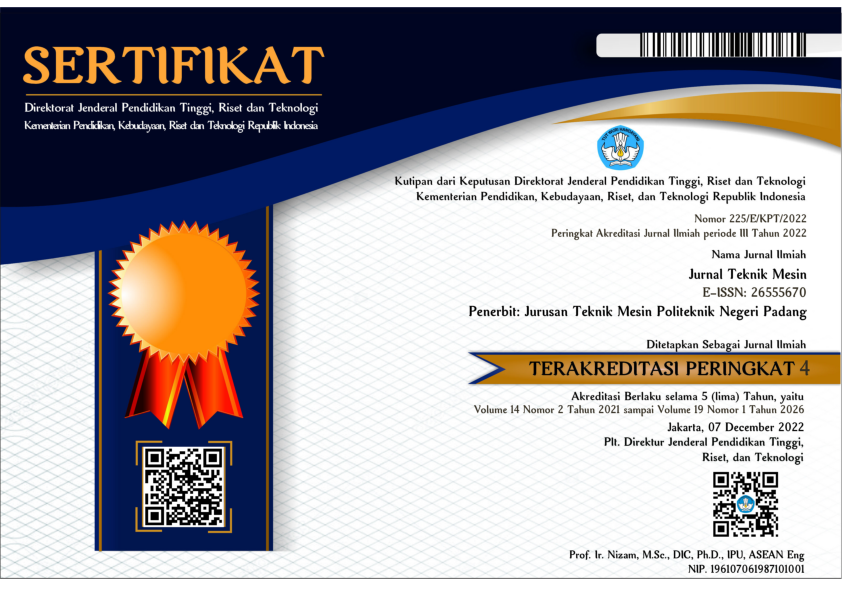Perancangan dan Analisis Daya Turbin Air Piko Hidro untuk Aliran Arus Rendah
Abstract
Over time, the consumption of electrical energy needed in Indonesia is getting bigger. Various efforts continue to be made either by seeking new energy potential or by developing existing technologies. Apart from the increasing need for electrical energy, efforts are made to supply the needs of electrical energy by utilizing the potential and conditions that exist in certain areas. Water energy has been widely utilized and used for power generation. The potential of water as an energy source can be used as a provider of electrical power. One of the uses of water energy is to make hydroelectric power plants. The purpose of this study is to design a portable water turbine design and find out the results of the calculation of the analysis of electrical power produced. The research method used is the analysis of water turbine design using the SolidWorks application to be able to find out the shape of the turbine that has simple, portable properties and can be carried anywhere. The size that meets the desired criteria is 10 cm for diameter and 4 cm for height. After designing the turbine design, then the calculation and analysis of the power released by the water turbine is carried out. The data needed to perform the calculation are water discharge 1.48×10-5 m3/s, head 6×10-2 m, water density 1000 kg/m3, gravity acceleration 9.81 m/s2, turbine efficiency 12.6%. Using the turbine power formula, the turbine power with a water discharge value of 1.48×10-5 m3/s is 11 Watts. Then the 2nd calculation was carried out with the value of the water discharge used of 9.6×10-5 m3/s and turbine efficiency of 24.9%. After calculation, the turbine power value of 14 Watts was obtained.
References
Setiawan, V. N. (2023, Juni 21). CNBC Indonesia. Retrieved September 11, 2023, from CNBC Indonesia.com: https://www.cnbcindonesia.com/news/20230621141815-4-447981/lebih-tinggi-pln-ramal-konsumsi-listrik-di-2023-melejit-6
Putra, A. (n.d.). berotak. Retrieved Maret 6, 2023, from https://www.berotak.com/rumus-daya-turbin/
Yulianto, R. (2020). Analisis Pengaruh Variasi Jumlah Sudu dan Sudut Serang Terhadap Kinerja Turbin Air Darrieus". Sainteknol,
B, & K. (2005). Modifikasi Pembangkit Listrik Tenaga Air dengan Menggunakan Turbin Pelton. Semarang: Teknik Mesin Universitas Dipenogoro.
Cesar, A., & Kurniawan, I. (2020). Kaji Eksperimental Turbin Air Darrieus Tipe-H Menggunakan Blade Hydrofoil Standar NACA 0018. FTEKNIK, 1.
Dewi, I. R. (2023, Januari 12). CNBC Indonesia. Retrieved September 11, 2023, from CNBC Indonesia.com: https://www.cnbcindonesia.com/tech/20230112172038-37-405066/warga-ri-sudah-candu-parah-nomor-satu-di-dunia
Zaira, J., & Naibaho, O. (2023). Rancang Bangun Pembangkit Listrik Pikohidro Menggunakan Turbin Screw Pada Aliran Danau PCR. Jurnal Teknik Mesin, 16(1), 1-8.
Duma, G., & Sule, L. (2022). Analisis Kinerja Turbin Air Arus Bawah Bentuk Sudu Bengkok 45o dengan Varias Material. Dinamika Teknik Mesin, 111-121.
Yuinarso, R. (2012). Analisa Perancangan Turbin Darrieus pada Hydrofoil Naca 0015 dari Karakteristik Cl dan Cd pada
H.S, & Rohermanto, A. (2006). Rancang Bangun Model Turbin Pelton Mini sebagai Media Simulasi/Praktikum Mata Kuliah dan Konversi Energi dan Mekanik Fluida. Pontianak: Teknik Mesin Politeknik Negeri Pontianak.













